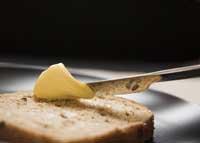Peter Borrows takes us on another excursion into local chemistry
Nanochemistry is everywhere, so why not look for evidence of the very small on a walk around town? By doing a few calculations we can highlight to youngsters just how small atoms and molecules really are. The calculations are similar to the familiar 'oil drop experiment' but presented in an everyday context. Although there are many questionable assumptions and approximations, the tasks do produce some interesting ballpark figures.
Tyre tread test
You pass a garage offering a special deal on new tyres. Typically, a new tyre has a tread depth of 9 mm and under UK law the tyre must be replaced when the depth reaches 1.6 mm, this leaves 7.4 mm of rubber that can be worn away before a tyre needs to be replaced. The question is, how much rubber is removed each time the tyre makes contact with the road? A molecule's worth per revolution? More? Less?
My car has wheels with a 179 cm circumference. The Automobile Association (AA) reports the average car tyre can expect to last 27,000 miles, ie 43.5 × 106 m. So my tyres should last for around 243 × 106 revolutions. Each revolution must therefore wear off about 3 × 10-11 m of rubber, or 0.03 nm, from the tyre.
It's difficult to estimate the dimensions of a rubber molecule but if we assume that a C-C bond is ca 0.15 nm long, then it will take around five rotations, or approximately 9 m, to remove one C-C bond. To simplify matters further, let's also assume that the rubber used in car tyres is a polymer of isoprene, C5 H8, with a relative molecular mass of about two million and a molecular formula approaching C147,000 H235,000. It therefore follows that one molecule of this compound should only be shed after about 735,000 rotations or 132 km.
Bear in mind though that when we're driving probably most of the rubber is shed only during braking. Nevertheless, this does also raise the question as to how such large molecules do actually get lost - does it really break up into pieces, or is the polymer lost a bond at a time? Does anyone know?

Mean margarine
Your walk around town takes you past a sandwich bar, where an assistant is buttering slices of bread. The assistant is not being generous with the butter or more probably margarine. So you might wonder, how many slices of bread could the assistant cover with just a single 500 g tub of margarine?
Let's assume that a slice of bread is a 10 cm square and that the mean assistant manages to make the margarine layer only one molecule thick. Let's also assume the margarine molecule is a cube with 2 nm sides (an estimate often used in the oil drop experiment) and its density is ca 0.94 g cm-3. One tub will therefore contain about 532 cm3, ie 532 × 10-6 m3 of margarine. Spread to a depth of 2 nm (2 × 10-9 m) the tub's contents will cover an area of 266,000 m2 or some 26.6 million slices. Seems a little margarine goes a long way.






No comments yet